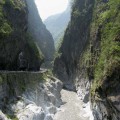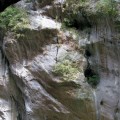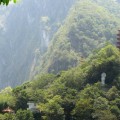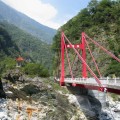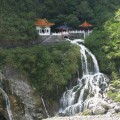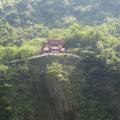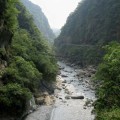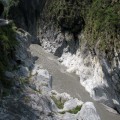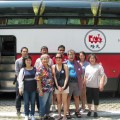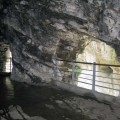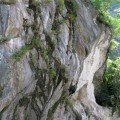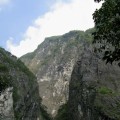Taroko is a part of the Hua Lien region of northern Taiwan. It is a mountainous terrain that is famous for its landscapes, marbles and stones. It is good to take the morning plane going there and return to Taipei on the afternoon train. That’s exactly what a group of 8 did although I heard that a Japanese man was probably left behind on the way back because we and the travel guide did not see him board the train or get off in Taipei.
After you arrive, you ride a bus and are taken to the first stop, a marble marker across from a red bridge. The marker has some calligraphy saying that this is Taroko. Everybody seems to carry a camera in this group and each one takes multiple photos of the place at each stop. From the gateway, you are taken from place to place, each spot an awesome scenery — dizzying cliffs and gorges, still or raging rivers (from the recent typhoon), temples on the marble mountainsides, and waterfalls. The cliffs have stunning textures, sometimes with caves, always with unusual patterns.
The mountainous range — there’s not just one single mountain or two, but many, each one with a cloud-covered summit. I wanted to do meditation and Tai chi but for an 8-hour visit, the time wasn’t enough even for doing one form. I probably should have decided to stay for 2 days at least. Camping is available, so for those who have plans of going there, it is something that should be seriously considered. On my trip to Huangshan/Yellow Mountain in 2007, 3 full days were allotted. I was able to trek up and down several peaks, do several sets of the Classical Yang Family Tai chi chuan form, walk up to a peak at 4 in the morning and watch the sunrise.
Even a remote region like Taroko, the roads and bridges are first-class. They reminded me of the roads and bridges of China and Thailand, countries that as far as I know have spent much of their budgets on infrastructure and not on external wars. The subway and train complexes of Taiwan and China are also excellent. One time in 2007, my friends and I took a taxi from Tunxi to Hangzhou. It took almost 5 hours to navigate the trip. Amazingly, the wide 4 lane highways, sometimes going through tunnels and passing unpopulated mountains, were all newly built.
